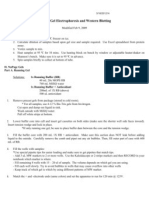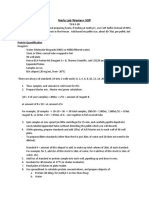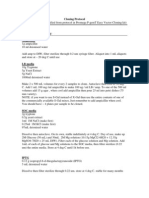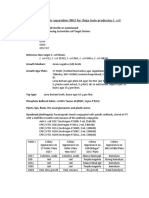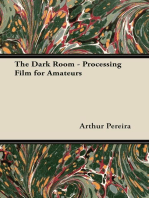Virtual Drug Screening Stream Spring 2011: Lab: Protein Characterization
Uploaded by
Keri Gobin SamarooVirtual Drug Screening Stream Spring 2011: Lab: Protein Characterization
Uploaded by
Keri Gobin SamarooVirtual Drug Screening stream
Spring 2011
Lab: Protein characterization
Objective
The purpose of this lab is to use gel electrophoresis to analyze the samples you prepared in
the previous 2 labs. In this lab you will analyze the protein samples that you collected during
the expression and purification labs. Sodium dodecyl sulfate polyacrylamide gel
electrophoresis (SDS-PAGE) will be used to separate proteins in your samples. Using the
electrophoresis and spectroscopy results you will estimate the molecular weight of the gbr22
protein as well as the purity and yield of the final purified protein product. This data will then
be correlated to the UV-Vis spectroscopy measurements that were made in the last lab to
estimate the concentration of your protein solution.
Lab Safety
Many of the chemicals used in electrophoresis are toxic and can be absorbed through the
skin. The stains used to visualize proteins will stain skin and clothing as well. Always wear
gloves while handling gels and gel apparatus and be careful. Any equipment or supplies
located in the gel electrophoresis area should be assumed to be contaminated and treated
with caution.
Background
When purifying proteins, there needs to be a method to monitor the success of each
separation step. While spectroscopy can be used to measure the concentration of proteins in
solution, it can not normally discriminate between different proteins in a mixture. The most
common technique used to follow expression and purification steps is sodium dodecyl sulfate
polyacrylamide gel electrophoresis (SDS-PAGE). In gel electrophoresis, the samples are
introduced at one end of a porous gel and an electrical field is applied across the gel using a
power supply.
SDS is an anionic detergent which denatures proteins and imparts a negative charge that is
proportional to its mass. This means that the distance of migration through the gel is related
only to the mass of the protein (since the charge/mass ratio stays the same for most proteins)
and the mass can be estimated by comparison to molecular weight standards.
Last week you purified a purple protein, called gbr22, and collected samples from the
different purification steps. In this lab you will characterize the purified protein using gel
electrophoresis and UV-Vis spectroscopy.
Lab Timeline:
Day 1: Preparing Samples: 30min-1hr
Loading and Running gel: 1 hr
Staining gel: 1 hr
Destain gel: overnight
Day 2: Take image of gel: 30 min
Dry gel: 2 hrs (can leave while drying and return at end)
Note: There is an overnight step for this lab.
necessary. Discuss with the RE.
This can be extended to 2 overnight if
Virtual Drug Screening stream
Spring 2011
Equipment and materials
Mini-PROTEAN electrophoresis tank and lid
Power supply and leads
TGS running buffer
Bio-Rad precast polyacrylamide gel
100 l 6x gel (or sample) loading buffer
Protein Samples #1-6 from Expression and Purification labs
Molecular Weight standards
Plastic container w/ lid
Imperial protein stain
Prelab calculations
1. Calculate the amount of 5x TGS buffer to use to make 500 ml of a solution that is 1x
TGS.
2. Calculate the amount of 6x sample loading buffer to add to 50 l of a protein sample
so that the final solution is 1x.
Experimental procedure
Preparing the SDS-PAGE gel samples
Samples 1-6 were collected during the protein expression and protein purification labs. You
will need to obtain a 100 l aliquot of 6x gel loading buffer from the TA/mentor. The loading
buffer contains glycerol, DTT (a chemical that reduces disulfide bonds), SDS, and the dye
bromophenol blue.
Sample 1 requires more preparation since it contains whole cells that were collected before
harvesting the culture. Prepare a counterbalance by pipetting 500 ul of water into a 1.7 ml
microcentrifuge tube. Using a benchtop microcentrifuge (refrigeration isnt necessary),
centrifuge sample 1 for 5 min at 5,000 rpm. After centrifuging you want to retain the pellet.
Remove the liquid (spent media) and dispose of in the bleach waste container, resuspend the
cell pellet in 200 l of water by pipetting up and down until there are no more clumps, and
add 40 l of loading buffer (you may need to cut the end off of the pipette tip so that it will be
wide enough to take up the very viscous solution also you can vortex the blue loading
buffer).
Samples 2-6 are 50 l protein aliquots of the
sequential purification steps. To each of these
tubes add the necessary amount of the 6x
loading buffer (calculated in Prelab Calculation
above) and pipette to mix. Place all the tubes
containing samples 1-6 into a heat block at
95C for 5 min. Remove tubes from the heat
block and centrifuge the tubes for 2 min at
5,000 rpm.
Assembling the electrophoresis module
A general diagram of the apparatus is shown to
right. For detailed instructions, refer to the
document SDS-PAGE using the miniPROTEAN in Equipment Instructions on
Blackboard. You will need: a mini-PROTEAN
tank, cover with attached electrical leads, gel
#2
the
Virtual Drug Screening stream
Spring 2011
clamping frame (electrode assembly), buffer dam, 500 ml of 1x TGS buffer, prepared protein
samples, and molecular weight standards.
Obtain a precast gel from the TA/mentor and remove from the packaging. Cut along the
dotted line at the bottom of the cassette with a razor blade and pull off the tape to expose the
slot along bottom edge of the gel. This is necessary to allow contact of the bottom of the gel
with the outer buffer reservoir. The gels come with a 10-well comb that is used to form the
wells. Remove the comb by sliding straight up.
Place the gel cassettes into the clamping frame with the shorter glass plates facing inward. If
you are running a single gel, use the buffer dam for the second gel position. The gels and
buffer dam should rest firmly against the green gaskets. Slide the green arms of the clamping
frame over the gels and lock into place. Check with the TA/mentor to confirm that you have
assembled the frame correctly.
Insert the assembly into the tank, making sure that the red
electrode jack matches the red marking on the inside of the tank.
With the buffer level markings on the front of the tank, the
assembly will fit in the position at the back of the tank. Fill the gel
clamping assembly (upper chamber) with 1x TGS buffer to the
top edge and fill the tank (lower chamber) to the level indicated
the front for 2 gels. You are now ready to load your samples into
the wells.
on
Sample loading and power conditions
Clear each lane by using a ~20 gauge needle and syringe. Take up a milliliter or two of TGS
buffer from the tank into the syringe and then inject into the well forcefully to clear it out. This
will allow the samples to run better.
Usually, the first well is skipped to prevent gel smiling or distortion. So, into the second
well, load 7 l of the MW standards (get from mentor) write down the name of the MW
standard that you used. (you will need it for the post lab). Use a 10 l pipettor and let it fall
gently into the well and sink to the bottom. Now, you can load 20 l of each protein sample
into each of the remaining wells using a P20 micropipettor. Take care not to puncture the gel
with the tips. Write down which sample is associated with which well.
Place the lid on the tank, aligning the color coded plugs and jacks and insert the electrical
leads into the power supply. Set the timer on the power supply to 25 minutes Set the voltage
to 200 V and select run. Verify that your gel is running by looking for rising gas bubbles. You
stop your gel when the blue line reaches a centimeter or two from the bottom of the gel. Do
not let it go too long or the low MW proteins may run off the bottom of the gel.
Removing and staining the gel
After the gel electrophoresis is done, turn off the power supply and disconnect the leads.
Remove the tank lid and pour off and discard the running buffer. Remove the gel cassette by
opening the arms of the assembly and gently peal the tape and separate the two plates along
the sides of the cassette. Remove the gel by floating it off the plate into a large plastic dish of
nanopure water. The gel is thin and somewhat fragile so handle with care or it will tear. Rinse
the tank, lid and assembly with DI water and hang to dry. Using tape, label your dish with
Name and Date.
To remove excess SDS which will inhibit the staining process, wash the gel three times for 5
minutes each time with ~100 ml of nanopure water (washing means letting it sit in the dish
Virtual Drug Screening stream
Spring 2011
while on the orbital shaker). Discard the water by pouring down the drain but dont lose
your gel! Mix the Imperial protein stain by inverting the bottle several times. Add a sufficient
volume of stain to completely cover the gel (~30 ml) and place on the orbital shaker for 1-1.5
hours until dark bands are very visible. Label the Petri dish with your initials and the date.
When finished with the staining, pour the used reagent into the container marked for used
stain this stain can used again.
To destain the gel add rinse twice with Nanopure water then add enough nanopure water in
the Petri dish to cover the gel (~100 ml). Place a folded tissue (KimWipe) in the dish (to soak
up excess stain) and wash the gel overnight on the orbital shaker to remove the background
staining.
Next Day:
Take a preliminary picture of the gel incase it does not survive the drying process
Use a white piece of paper as the background and the digital camera. Make sure your bands
are distinguishable in the image.
Alternatively, use the flat bed scanner. Lay a piece of saran wrap on the flat bed
scanner then flip your gel on top so it is face down. Cover with another piece of saran wrap.
Get as many wrinkles out as you can.
Save a copy for yourself on webspace or a USB drive.
Post your image online to Wiki page.
Dry the gel
Materials: Whatman paper, sarah wrap,
labeling pen
(DO NOT write on the paper before
drying wait til after!)
gel,
At one of the appointed times, take
your
gel over to the Biotech lab to be dried so
that
you can save it and put in your notebook.
Cut
a piece of Whatman filter paper that is
large enough to cover your gel plus extra
room for labeling. Wet the paper and put your gel on top of this. Cover with Saran Wrap (or
cellophane more permanent). Then lay them on the drying bed. Lay the sealing gasket
over everything.
Set temp to 75OC on Gradient cycle for 1.5 hrs.
Turn on vacuum and start cycle.
You can check your gel by lifting the lid - A dry gel should be warm over the entire surface.
Once dry, break the vacuum seal first by lifting the sealing gasket. Then turn off the vacuum
pump. You can trim around the paper that the gel is stuck to (but leave room for labeling). On
the front of the paper, Write Name, Date, VDS, and what the gel is i.e. label what is in each
lane.
Take a picture of your dried gel.
Flip a coin to determine who gets to paste the actual dried gel in their Lab Notebook. The
other person will need to print out a picture of it.
Questions that should be answered in the course of your Lab Report (estimating
molecular weight, purity and yield):
On the internet, look up the Molecular Weight standard that you used. You should find an
image similar to the one at the right. Print this out for your lab notebook and post an
Virtual Drug Screening stream
Spring 2011
electronic copy for your Wiki Lab Report. Now, estimate the MW of your purified protein
using the standards as a reference.
Examples of Bio-Rad Molecular Weight Standards
How many other protein bands are present in the sample 5 lane? If there was one other
band of equal intensity, the estimated purity would be 50%.
What do you estimate the purity of your final protein (sample 5) to be?
Lab Notebook:
Use hand drawn diagrams when applicable
Record the steps taken and include images of your gel
Online Report: use your page on the WikiSpaces (under Protein Labs)
Lab Report: Due Monday April 18th at Midnight (or before Dr. B checks in the morning!)
This report will encompass the last three (3) labs: protein expression, purification, and
characterization.
1,250 words total
Since this is online you must be efficient with your words! Make them count!
Title: think of something semi-creative
Intro words: this should have some information on protein production and
purification.
There is a good article here:
Nat Methods. 2008 Feb;5(2):135-46.
Protein production and purification.
Also a good website:
http://www.embl.de/pepcore/pepcore_services/index.html
End with a transition statement where you briefly sum-up what was done in
these labs and its importance. No need for a hypothesis in this write up.
M&M 250 words: be succinct while allowing an informed reader to be able to
replicate your work. Do not show calculations for prelabs.
Results: show images of your results that you have already taken
Transformation plates images - Mention how many colonies you got. Flask
images, purple pellet images (include the weight of your pellet)
Images of Elution 1 and 2 in tubes, Nanodrop screen shots - Include
yields from your Nanodrop spectrophotometry for your protein amounts.
Show calculations for Beers law calculatins.
Protein Gel images, Image of Ladder (molecular weight marker used)
Discusssion
Analyze your results, address sources of error, answer any questions from the
handout
Conclusions
References
You might also like
- Genei: Western Blotting Teaching Kit ManualNo ratings yetGenei: Western Blotting Teaching Kit Manual10 pages
- ASTM-A449: Licensed by Information Handling Services Licensed by Information Handling ServicesNo ratings yetASTM-A449: Licensed by Information Handling Services Licensed by Information Handling Services7 pages
- Protein Isolation(,physical) and SDS PAGENo ratings yetProtein Isolation(,physical) and SDS PAGE5 pages
- 23-24 - Practical 1 - p16 As A Biomarker of HypoxiaNo ratings yet23-24 - Practical 1 - p16 As A Biomarker of Hypoxia6 pages
- Electroforesis en Gel para Moléculas de ADNNo ratings yetElectroforesis en Gel para Moléculas de ADN5 pages
- SDS-Polyacrylamide Gel Electrophoresis of ProteinsNo ratings yetSDS-Polyacrylamide Gel Electrophoresis of Proteins9 pages
- Activity 2. Gel Extraction and PurificationNo ratings yetActivity 2. Gel Extraction and Purification5 pages
- Rat PDGF (Platelet-Derived Growth Factor) ELISA Kit: Instruction ManualNo ratings yetRat PDGF (Platelet-Derived Growth Factor) ELISA Kit: Instruction Manual9 pages
- Week 3 Yeast Research Project: CerevisiaeNo ratings yetWeek 3 Yeast Research Project: Cerevisiae5 pages
- Mouse IL-8 (Interleukin 8) ELISA Kit: Instruction ManualNo ratings yetMouse IL-8 (Interleukin 8) ELISA Kit: Instruction Manual9 pages
- Sds-Polyacrylamide Gel Electrophoresis IntroductionNo ratings yetSds-Polyacrylamide Gel Electrophoresis Introduction5 pages
- Super Protocol For Extremely High Dna Yields! Inexpensive! Training Required!No ratings yetSuper Protocol For Extremely High Dna Yields! Inexpensive! Training Required!7 pages
- Protocolo JOVE - Preparação-cortes-imunoNo ratings yetProtocolo JOVE - Preparação-cortes-imuno6 pages
- MCBI DNA Science Practical Extraction, Purification and Analysis of Plasmid DNA Aim: Learning OutcomesNo ratings yetMCBI DNA Science Practical Extraction, Purification and Analysis of Plasmid DNA Aim: Learning Outcomes2 pages
- Human DSP (Dentin Sialoprotein) ELISA KitNo ratings yetHuman DSP (Dentin Sialoprotein) ELISA Kit9 pages
- Isolation and Analysis of Urinary Glycosaminoglycans: ReagentsNo ratings yetIsolation and Analysis of Urinary Glycosaminoglycans: Reagents5 pages
- ELISA Kit For Angiotensin II (AngII) E90005RaNo ratings yetELISA Kit For Angiotensin II (AngII) E90005Ra8 pages
- AQC-321, E-Practical Manual On Introduction To Biotechnology and Bioinformatics (Dr. M.L. Ojha, 05-02-2021)No ratings yetAQC-321, E-Practical Manual On Introduction To Biotechnology and Bioinformatics (Dr. M.L. Ojha, 05-02-2021)41 pages
- AS Gluten (COKAL0210AS) - Package Insert_Original_20225 (1)No ratings yetAS Gluten (COKAL0210AS) - Package Insert_Original_20225 (1)8 pages
- Flow charts of pharmaceutical quality control tests for different dosage formsFrom EverandFlow charts of pharmaceutical quality control tests for different dosage formsNo ratings yet
- Turning Android Smartphones Into Professional Thermography CamerasNo ratings yetTurning Android Smartphones Into Professional Thermography Cameras4 pages
- Table of Important Fourier Tranforms For Signals and SystemsNo ratings yetTable of Important Fourier Tranforms For Signals and Systems1 page
- Unit 1 APES: Chapter 1, Living in The Environment, OutlineNo ratings yetUnit 1 APES: Chapter 1, Living in The Environment, Outline9 pages
- Lab 5: Determination of Fluoride in Commercial Products and Water With An Ion Selective Electrode100% (1)Lab 5: Determination of Fluoride in Commercial Products and Water With An Ion Selective Electrode11 pages
- Determination of True Stress-Strain Curve of TypeNo ratings yetDetermination of True Stress-Strain Curve of Type32 pages
- GeneJET PCR Purification Kit T - Chalmers-Gothenburg - Thermo ScientificNo ratings yetGeneJET PCR Purification Kit T - Chalmers-Gothenburg - Thermo Scientific9 pages
- Pierce Cell Surface Protein Biotinylation and Isolation Kit: User GuideNo ratings yetPierce Cell Surface Protein Biotinylation and Isolation Kit: User Guide5 pages
- 9202 92022 International Gcse Chemistry Specimen Paper v2No ratings yet9202 92022 International Gcse Chemistry Specimen Paper v226 pages
- 1.2 Raw Materials and Its Preparation For Iron Making100% (2)1.2 Raw Materials and Its Preparation For Iron Making107 pages
- En 10225 Chemical & Mechanical ProprietiesNo ratings yetEn 10225 Chemical & Mechanical Proprieties2 pages
- Flashcards - Topic 2.2 Thermal Properties - CAIE Physics IGCSENo ratings yetFlashcards - Topic 2.2 Thermal Properties - CAIE Physics IGCSE45 pages
- Nickel-Silicon-Chromium - Molybdenum - Vanadium-Steel (Vacuum Arc Remelted) Billets, Bars, Forgings and PartsNo ratings yetNickel-Silicon-Chromium - Molybdenum - Vanadium-Steel (Vacuum Arc Remelted) Billets, Bars, Forgings and Parts8 pages
- 8250 RUST INHIBITIVE OIL CK Rev (1409) PDFNo ratings yet8250 RUST INHIBITIVE OIL CK Rev (1409) PDF2 pages
- ASTM-A449: Licensed by Information Handling Services Licensed by Information Handling ServicesASTM-A449: Licensed by Information Handling Services Licensed by Information Handling Services
- 23-24 - Practical 1 - p16 As A Biomarker of Hypoxia23-24 - Practical 1 - p16 As A Biomarker of Hypoxia
- SDS-Polyacrylamide Gel Electrophoresis of ProteinsSDS-Polyacrylamide Gel Electrophoresis of Proteins
- Rat PDGF (Platelet-Derived Growth Factor) ELISA Kit: Instruction ManualRat PDGF (Platelet-Derived Growth Factor) ELISA Kit: Instruction Manual
- Mouse IL-8 (Interleukin 8) ELISA Kit: Instruction ManualMouse IL-8 (Interleukin 8) ELISA Kit: Instruction Manual
- Sds-Polyacrylamide Gel Electrophoresis IntroductionSds-Polyacrylamide Gel Electrophoresis Introduction
- Super Protocol For Extremely High Dna Yields! Inexpensive! Training Required!Super Protocol For Extremely High Dna Yields! Inexpensive! Training Required!
- MCBI DNA Science Practical Extraction, Purification and Analysis of Plasmid DNA Aim: Learning OutcomesMCBI DNA Science Practical Extraction, Purification and Analysis of Plasmid DNA Aim: Learning Outcomes
- Isolation and Analysis of Urinary Glycosaminoglycans: ReagentsIsolation and Analysis of Urinary Glycosaminoglycans: Reagents
- AQC-321, E-Practical Manual On Introduction To Biotechnology and Bioinformatics (Dr. M.L. Ojha, 05-02-2021)AQC-321, E-Practical Manual On Introduction To Biotechnology and Bioinformatics (Dr. M.L. Ojha, 05-02-2021)
- AS Gluten (COKAL0210AS) - Package Insert_Original_20225 (1)AS Gluten (COKAL0210AS) - Package Insert_Original_20225 (1)
- Flow charts of pharmaceutical quality control tests for different dosage formsFrom EverandFlow charts of pharmaceutical quality control tests for different dosage forms
- The Dark Room - Processing Film for AmateursFrom EverandThe Dark Room - Processing Film for Amateurs
- Turning Android Smartphones Into Professional Thermography CamerasTurning Android Smartphones Into Professional Thermography Cameras
- Table of Important Fourier Tranforms For Signals and SystemsTable of Important Fourier Tranforms For Signals and Systems
- Unit 1 APES: Chapter 1, Living in The Environment, OutlineUnit 1 APES: Chapter 1, Living in The Environment, Outline
- Lab 5: Determination of Fluoride in Commercial Products and Water With An Ion Selective ElectrodeLab 5: Determination of Fluoride in Commercial Products and Water With An Ion Selective Electrode
- GeneJET PCR Purification Kit T - Chalmers-Gothenburg - Thermo ScientificGeneJET PCR Purification Kit T - Chalmers-Gothenburg - Thermo Scientific
- Pierce Cell Surface Protein Biotinylation and Isolation Kit: User GuidePierce Cell Surface Protein Biotinylation and Isolation Kit: User Guide
- 9202 92022 International Gcse Chemistry Specimen Paper v29202 92022 International Gcse Chemistry Specimen Paper v2
- 1.2 Raw Materials and Its Preparation For Iron Making1.2 Raw Materials and Its Preparation For Iron Making
- Flashcards - Topic 2.2 Thermal Properties - CAIE Physics IGCSEFlashcards - Topic 2.2 Thermal Properties - CAIE Physics IGCSE
- Nickel-Silicon-Chromium - Molybdenum - Vanadium-Steel (Vacuum Arc Remelted) Billets, Bars, Forgings and PartsNickel-Silicon-Chromium - Molybdenum - Vanadium-Steel (Vacuum Arc Remelted) Billets, Bars, Forgings and Parts









